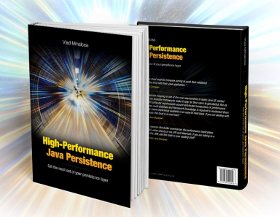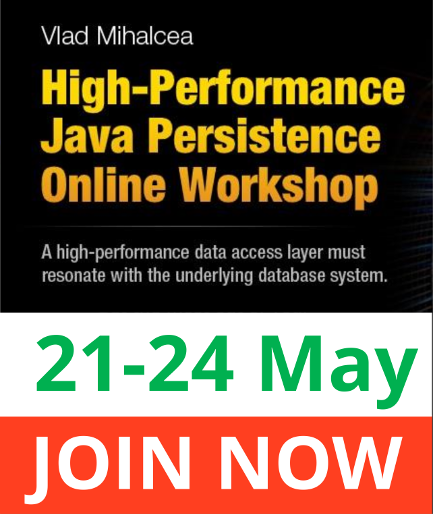Overriding FetchType.EAGER with fetchgraph
Imagine having a tool that can automatically detect JPA and Hibernate performance issues. Wouldn’t that be just awesome?
Well, Hypersistence Optimizer is that tool! And it works with Spring Boot, Spring Framework, Jakarta EE, Java EE, Quarkus, or Play Framework.
So, enjoy spending your time on the things you love rather than fixing performance issues in your production system on a Saturday night!
Introduction
In this article, we are going to see how you can override the FetchType.EAGER strategy using the fetchgraph query hint.
While this feature has been available in the JPA specification since version 2.1, Hibernate has only supported this feature since version 5.5.
The best way to use the JPA OneToOne optional attribute
Imagine having a tool that can automatically detect JPA and Hibernate performance issues. Wouldn’t that be just awesome?
Well, Hypersistence Optimizer is that tool! And it works with Spring Boot, Spring Framework, Jakarta EE, Java EE, Quarkus, or Play Framework.
So, enjoy spending your time on the things you love rather than fixing performance issues in your production system on a Saturday night!
Introduction
In this article, we are going to see what is the best way we can use OneToOne optional attribute so that we can avoid N+1 query issues.
How to calculate percentiles with SQL PERCENTILE_CONT
Imagine having a tool that can automatically detect JPA and Hibernate performance issues. Wouldn’t that be just awesome?
Well, Hypersistence Optimizer is that tool! And it works with Spring Boot, Spring Framework, Jakarta EE, Java EE, Quarkus, or Play Framework.
So, enjoy spending your time on the things you love rather than fixing performance issues in your production system on a Saturday night!
Introduction
In this article, we are going to investigate how to calculate percentiles with the SQL PERCENTILE_CONT function.
PostgreSQL FOR UPDATE vs FOR NO KEY UPDATE
Imagine having a tool that can automatically detect JPA and Hibernate performance issues. Wouldn’t that be just awesome?
Well, Hypersistence Optimizer is that tool! And it works with Spring Boot, Spring Framework, Jakarta EE, Java EE, Quarkus, or Play Framework.
So, enjoy spending your time on the things you love rather than fixing performance issues in your production system on a Saturday night!
Introduction
In this article, we are going to investigate the difference between the PostgreSQL FOR UPDATE and FOR NO KEY UPDATE when locking a parent record and inserting a child row.
PostgreSQL Heap-Only-Tuple or HOT Update Optimization
Imagine having a tool that can automatically detect JPA and Hibernate performance issues. Wouldn’t that be just awesome?
Well, Hypersistence Optimizer is that tool! And it works with Spring Boot, Spring Framework, Jakarta EE, Java EE, Quarkus, or Play Framework.
So, enjoy spending your time on the things you love rather than fixing performance issues in your production system on a Saturday night!
Introduction
In this article, we are going to analyze how PostgreSQL Heap-Only-Tuple or HOT Update optimization works, and why you should avoid indexing columns that change very frequently.
PostgreSQL Index Types
Imagine having a tool that can automatically detect JPA and Hibernate performance issues. Wouldn’t that be just awesome?
Well, Hypersistence Optimizer is that tool! And it works with Spring Boot, Spring Framework, Jakarta EE, Java EE, Quarkus, or Play Framework.
So, enjoy spending your time on the things you love rather than fixing performance issues in your production system on a Saturday night!
Introduction
In this article, we are going to analyze the PostgreSQL Index Types so that we can understand when to choose one index type over the other.
When using a relational database system, indexing is a very important topic because it can help you speed up your SQL queries by reducing the number of pages that have to be scanned or even avoid some operations altogether, such as sorting.
If you want to receive automatic index and SQL rewrite recommendations based on your database workloads, check out EverSQL by Aiven.
How to map the OffsetDateTime ZoneOffset with Hibernate TimeZoneColumn
Imagine having a tool that can automatically detect JPA and Hibernate performance issues. Wouldn’t that be just awesome?
Well, Hypersistence Optimizer is that tool! And it works with Spring Boot, Spring Framework, Jakarta EE, Java EE, Quarkus, or Play Framework.
So, enjoy spending your time on the things you love rather than fixing performance issues in your production system on a Saturday night!
Introduction
In this article, we are going to see how we can map the OffsetDateTime ZoneOffset with the Hibernate TimeZoneColumn annotation.
As I explained in this article, by default, Hibernate doesn’t store the time-zone offset of an OffsetDateTime entity attribute in a separate column. Instead, the OffsetDateTime is stored as a java.time.Instant that is relative to the UTC time zone.
However, there are use cases when we need to save the associated ZoneOffset, and that’s exactly when you would use the TimeZoneColumn annotation.





